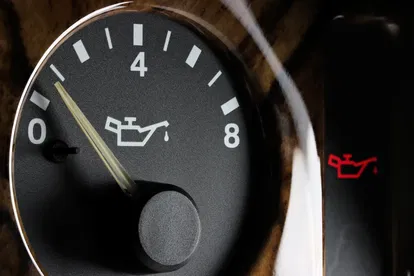Category:
What Does Low Oil Pressure Mean? What Causes It?

Low oil pressure can mean a few different things. Some are no big deal, but others can sideline your engine fast.
In this article, we’ll walk you through what low oil pressure really means, what causes it, and what to do next.
What Does Low Oil Pressure Mean?
Oil pressure is all about keeping your engine parts moving smoothly without grinding themselves to dust.
When your engine runs, the oil pump pushes oil through narrow passages to lubricate components like the crankshaft, camshaft, bearings, and valve train. This pressurized flow keeps everything running cool, clean, and protected.
Low oil pressure simply means that oil isn’t flowing through the system the way it should. That could be because there’s not enough oil, the pump isn’t pushing hard enough, or the oil isn’t getting where it needs to go.
Whatever the reason, the result is the same: your engine isn’t getting the protection it needs.
This matters because engines are built with tight tolerances. Without proper oil pressure, metal parts start to make direct contact and that’s when wear, overheating, and real damage kicks in.
What Should You Do If the Oil Pressure Light Stays On?
It might be tempting to try to finish the drive and deal with it later — but if that oil pressure light stays on, ignoring it can cost a lot more than time.
Pull over safely and shut it down. Check your oil level if you’re in a spot where you can, but don’t just top it off and hit the gas unless you know what you’re dealing with. If pressure is truly low, running the engine can turn a small problem into a full-on failure.
Whether you’re behind the wheel of a pickup or managing a dozen trucks in the field, the rule stays the same: if that light stays on, it’s time to investigate before things get worse.
What Are the Signs Your Oil Pressure Is Too Low?
The light is helpful, but it’s not the only sign your engine might be running dry. Oil pressure issues can sneak up in more ways than one, especially if you’re busy and your rig’s still running.
These are the warning signs we see out in the field:
- Engine noise: If you start hearing ticking, knocking, or clattering, that could be parts making metal-on-metal contact. Not normal. Not good.
- Overheating: Oil doesn’t just lubricate — it helps regulate engine temp. If pressure drops, friction builds, and things heat up fast.
- Drop in performance: Sluggish acceleration or weird hesitation? Low oil pressure can throw off timing and flow.
- Burning oil smell: That sharp, smoky car smell is your cue to check the oil. You might be leaking or burning it off without realizing it.
- Oil pressure gauge reads low: If you’ve got a gauge, don’t ignore it. Consistently low readings — even without a light — should get your attention.
If your engine starts acting off, don’t chalk it up to “just one of those days.” It might be trying to tell you something important.
How Do You Fix Low Oil Pressure and Keep It From Coming Back?
Fixing low oil pressure isn’t always complicated, but it does require a little know-how and a smart plan of action.
Here’s how to approach it:
- Start simple: Check your oil level and condition. Low or dirty oil is one of the most common causes and easiest fixes.
- Look for leaks: Check under the vehicle and around seals. If oil’s escaping, pressure won’t hold.
- Swap the filter: A clogged oil filter can restrict flow and throw off pressure. A fresh one can make all the difference.
- Check your oil pump: If the basics look good, your pump might not be pushing hard enough. This one’s best left to a pro.
- Don’t rule out the sensor: Sometimes, it is just the gauge or sensor that’s off, but don’t assume that’s the case until you’ve ruled out the real risks.
If you’re managing multiple vehicles or daily equipment, prevention is crucial.
At Cadence, we help keep things running. From premium oils and private-label blends to smart delivery packages that make stocking up easy, we make it simple to stay ahead of issues across fleets, farms, and shop floors alike.
The Bottom Line
So, what does low oil pressure mean? It means something’s disrupting oil flow. The causes can range from low oil to worn parts, but the outcome is the same if ignored: downtime, damage, and costly repairs.
At Cadence, we’ve seen every scenario. Whether you need better products, smarter logistics, or someone who speaks your language, we’re here to keep you moving.
Sources:
Causes of Low Oil Pressure in Engines | Machinery Lubrication
5 Ways to Be a Defensive Driver (for Teens) | Nemours KidsHealth